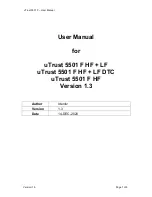
Chapter 11: Interrupts
11–5
Interrupts for Root Ports Using the Avalon-ST Interface to the Application Layer
November 2012
Altera Corporation
Arria V GZ Hard IP for PCI Express
illustrates the timing for deassertion of legacy interrupts. The assertion of
app_int_ack
instructs the Hard IP for PCI Express to send a
Deassert_INTA
message.
Interrupts for Root Ports Using the Avalon-ST Interface to the
Application Layer
In Root Port mode, the Arria V GZ Hard IP for PCI Express receives interrupts
through two different mechanisms:
■
MSI—Root Ports receive MSI interrupts through the Avalon-ST RX TLP of type
MWr
. This is a memory mapped mechanism.
■
Legacy—Legacy interrupts are translated into TLPs of type
Message
Interrupt
which is sent to the Application Layer using the
int_status[3:0]
pins.
Normally, the Root Port services rather than sends interrupts; however, in two
circumstances the Root Port can send an interrupt to itself to record error conditions:
■
When the AER option is enabled, the
aer_msi_num[4:0]
signal indicates which
MSI is being sent to the root complex when an error is logged in the AER
Capability structure. This mechanism is an alternative to using the
serr_out
signal. The
aer_msi_num[4:0]
is only used for Root Ports and you must set it to a
constant value. It cannot toggle during operation.
■
If the Root Port detects a Power Management Event, the
pex_msi_num[4:0]
signal
is used by Power Management or Hot Plug to determine the offset between the
base message interrupt number and the message interrupt number to send
through MSI. The user must set
pex_msi_num[4:0]
to a fixed value.
The
Root Error Status
register reports the status of error messages. The
Root Error
Status
register is part of the PCI Express AER Extended Capability structure. It is
located at offset 0x830 of the Configuration Space registers.
Interrupts for Endpoints Using the Avalon-MM Interface to the
Application Layer
The PCI Express Avalon-MM bridge supports MSI or legacy interrupts. Support
requires instantiation of the CRA slave module where the interrupt registers and
control logic are implemented.
The PCI Express Avalon-MM bridge supports the Avalon-MM individual requests
interrupt scheme: multiple input signals indicate incoming interrupt requests, and
software must determine priorities for servicing simultaneous interrupts the
Avalon-MM Arria V GZ Hard IP for PCI Express receives.
Figure 11–6. Legacy Interrupt Deassertion
clk
app_int_sts
app_int_ack
















































